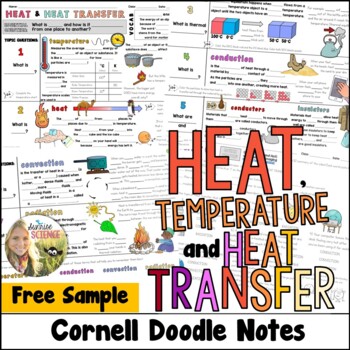Heat Transfer Thermal Energy Doodle Notes Middle School Science Cornell Notes
- PDF
Description
These FREE! Cornell Doodle Notes combine two effective note-taking strategies and can be used to introduce or review the concepts of temperature, heat, and the types of heat transfer: conduction, convection, and radiation. The notes begin by defining temperature and heat to make clear that temperature is a measure of the average kinetic energy of an object or substance while heat is the flow of energy from hotter to cooler places. The notes define and give real-life examples of conduction, conductors, insulators, convection and convection currents, and thermal radiation. The concepts align with the Disciplinary Core Ideas of NGSS MS-PS3-3, MS-PS3-4, and MS-PS1-4.
Cornell Notes are a note-taking strategy in which topic questions are written in a narrow left-hand column and definitions, explanations, and diagrams are filled in in the right-hand column.
Doodle Notes are another note-taking strategy for which pictures and graphics activate the visual pathways of the brain, which helps with retention of information when compared to standard note-taking. Your visual learners will really benefit from seeing and coloring in the pictures aside the main points of the notes!
This is a Free Sampler of my Heat, Temperature, and Heat Transfer Cornell Doodle Notes and Presentation, which includes a second scaffolded version of the notes, 20-slide Powerpoint AND Google Slides presentations, and a Google Slides digital version of the notes.
Doodle notes is a trademarked term used with permission. Please visit doodlenotes.org for more information.
Thanks for looking!
Sunrise Science





